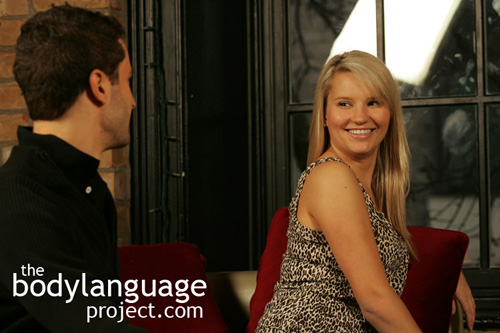
Standing up while others are seated instantly creates dominance.
If your goal is to gain the dominance advantage, but nature dealt you the short stack, there are several ways to use your environment in your favour. One of which is to create a scenario where it is natural to present to a seated audience. Obviously this particular example is more suitable to a boardroom business meeting, but can also be amongst friends by roaming a room, rather than taking a fix seat while entertaining. When created an artificial scenario it would be wise to include ample comfortable seating to provide an incentive for people to plop themselves down. A man might use the standing advantage at a bar to pick up women by waiting for her sit instead of approaching her while she dances. Present to the seated naturally gives you a large height advantage.

This cop knows his game. By keeping the suspect in his car he gains height-authority over him.
Stages by their nature are designed to give power to the speaker. Fewer interruptions from the audience is the direct result of being higher than them. It is very unnatural to address someone with any degree of authority from a lower position and we instinctively know this. If there are height differences and levels about a room, such as split levels or stairs, and your goal it to intimate or dominant someone, then use them. For example, standing on an upper step with your target below you will give you the upper hand every time. Addressing someone taller than you from an elevated position such that their height is negated will make them feel very uncomfortable and uneasy. They aren’t used to playing short stacked and they will probably do their best to rebalance the field in their favour when the opportunity arises. Try this experiment on door-to-door solicitors the next time they interrupt you. First, be sure to use the door as a barrier never quite opening it fully, and never ever invite them in. If you have a glass portion of your door, close the door slightly so as to be speaking through the glass. Ideally this will force them to address you from the next step which will be lower giving you at least a six inch height advantage. This is usually enough to stifle their pitch or at least annoy them. Next close and re-open the door at random intervals. This might seem cruel, but remember you never invited them, so they brought it upon themselves!
While lifts in shoes are out of style for men, there exits shoe brands and inserts that can add up to two inches of height. If you are 5’8”, then two inches can make a big difference in the height game, and put you into or above the average. Women know the power of heels all to well, and should use it to their advantage whenever possible in business and even in dating. The exception though is when the purpose is to build cooperation rather than asserting competence. Women should use heels in dating to set their benchmark height. It is universally recognized that women prefer men to be two to three inches taller than they are. By simply using a heel of that height and eliminating men who don’t stack up, they can immediately thwart unwanted advances. Most men won’t solicit from women taller than they are.
As we saw, forcing others to sit while we stand can helps neutralize height differences, but so too does mutually sitting. If both parties are forced to sit, the advantage is given to those that have the biggest rear ends rather than those with the longest legs. The extra cushion serves to prop them up! The largest differences in heights is largely due to the biggest bones in our bodies which is our legs, not our spines, although they do play a part. Sitting down, takes our legs out of commission. Next we should try to hold good posture and if our company has poor posture, we can negate all or most of the height difference. Sitting on opposite sides of the table negates height differences even further because separation makes it difficult to make the height comparison. The same tactic can be used while standing just by taking a step back.
An advanced, although cruel tactic includes sabotaging others by providing them with lower chairs. It’s not uncommon in the interview process to give prospects unpadded chairs with short legs. When multiple people are present, just claim the tallest chair! A chair with an abnormally tall back commonly used by royalty will make someone appear shorter due to perspective, but will also serve to make them appear more dominant and authoritative.
If presented with a power player who insists on interrupting and talking over you or others especially while seated, play their game. Instead of taking it sitting down, stand up, walk about the room, move away from the situation or move to the opposite side of the desk or table or use misdirection by looking out a window pretending to ponder his position. Each of these actions will unnerve them forcing them to up their game or concede. The simplest and most honest tactic is to hold better, more upright posture, which in and of itself can add inches over people with poor posture. Most people have a bad habit of slouching, so using better posture on its own makes you appear more confident by comparison.
If your objective is to maintain common ground instead of exploiting it, then the best bet it to try to level or lessen height differences instead of exploiting them. Tall women know this all to well, and can be found with poor posture usually because they stand out from the crowd and get teased as teenagers. Unfortunately, instead of walking tall, they hunch up trying to appear subordinate so they fit into the crowd unnoticed. Obviously, tall women who slouch are self-conscious of their height.
This not-withstanding reducing height differences fosters cooperation and reduces tension. Tall people should take notes and reverse all that was said above with respect to exploiting height differences. Most of what was mentioned was methods to use height to manipulate or create power imbalances. If the goal is to achieve cooperation, then we should be careful to try to level height differences instead of maximizing them. We should rarely show submission though, as it can be as disastrous as showing dominance when trying to build cooperation. We never want to appear weak even as we seek common ground.




